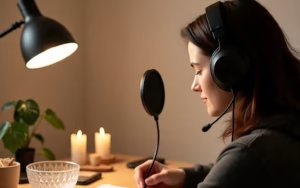ASMR (Autonomous Sensory Meridian Response) videos have exploded in popularity over the past decade. These videos trigger a tingling sensation, often starting from the scalp and traveling down the spine, by using soft sounds, whispering, and slow movements. Many people use ASMR content to relax, sleep, or reduce anxiety. If you’re interested in creating your own ASMR videos, this guide will walk you through the basics.
1. Understand Your Audience
Before diving into production, it’s essential to understand why people watch ASMR videos. Most viewers are looking for:
- Relaxation or sleep aids
- Relief from stress or anxiety
- Focus while studying or working
Knowing your audience will help you choose the right sounds, themes, and tone. Some people enjoy whispering, while others prefer tapping, crinkling, brushing, or roleplay scenarios (like spa visits or doctor check-ups). Browse popular ASMR channels to identify what resonates most.
2. Choose a Niche or Trigger
ASMR videos often focus on specific “triggers,” which are stimuli that provoke the tingling response. Some common ASMR triggers include:
- Whispering or soft speaking
- Tapping on hard surfaces
- Crinkling paper or plastic
- Hair brushing
- Page turning
- Mouth sounds
- Roleplay (e.g., makeup artist, doctor, librarian)
You can experiment with different triggers, but it’s a good idea to start with ones that you personally enjoy or find effective. Staying authentic will help build a loyal audience.
3. Set Up a Quiet Recording Environment
Sound is the most critical component of an ASMR video. Your recording space should be as quiet as possible. Turn off fans, air conditioners, or other appliances. Record during quiet hours, and consider using soundproofing materials like foam panels, blankets, or thick curtains.
4. Invest in the Right Equipment
Good audio quality is key for ASMR. While you don’t need to break the bank, some basic gear can significantly improve your recordings:
- Microphone: A high-quality condenser or binaural microphone is ideal. The Blue Yeti is a popular starter option.
- Pop filter: Helps reduce harsh sounds from speech and breathing.
- Headphones: Use them while editing to catch subtle noises.
- Camera: If you’re including video, a decent webcam or DSLR will do. Lighting also matters—soft, diffuse lighting creates a calming atmosphere.
5. Plan Your Content
Decide the structure of your video. Will it be a 10-minute whisper session, a 30-minute roleplay, or a sound assortment? Write down a rough outline to stay on track. For roleplays, you might script some dialogue. For sound videos, organize your tools (brushes, paper, etc.) beforehand.
6. Record with Care
When recording, take your time. ASMR is all about slow, deliberate movements and clear, crisp sounds. Speak softly, avoid sudden loud noises, and keep your pace steady. Always monitor your audio levels to avoid distortion or clipping.
If you’re using a stereo or binaural mic, play with microphone positioning to create immersive left-right sound effects. This spatial audio experience is part of what makes ASMR so engaging.
7. Edit Thoughtfully
Editing allows you to enhance audio quality and remove unwanted noise. Use software like Audacity (free) or Adobe Audition (paid) to:
- Reduce background noise
- Normalize volume levels
- Remove pops and clicks
- Add gentle fade-ins or fade-outs
For video editing, software like iMovie, DaVinci Resolve, or Adobe Premiere Pro can help you trim clips, sync audio, and add subtitles or background visuals if needed.
8. Publish and Promote
Upload your finished video to a platform like YouTube, using keywords in your title and description to help people find it. Include timestamps for triggers if your video has multiple sections. Use relevant tags like #ASMR, #SleepAid, or #Relaxation.
Engage with your viewers in the comments, take suggestions, and remain consistent with your uploads. Building an ASMR channel takes time, but authenticity and quality go a long way.
Final Thoughts
Creating ASMR videos is a rewarding and creative process. Whether you aim to help others relax or explore your own artistic side, ASMR is a unique genre that continues to grow. Start small, be patient, and most importantly—enjoy the calm you bring to others.
Ask ChatGPT




